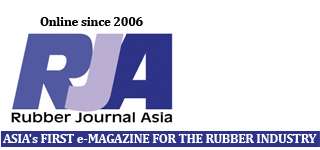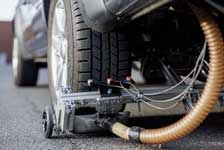German tyre firm Continental says it is pushing forward with efforts to reduce tyre wear by carrying out research and actively participating in various industry initiatives.
According to a recent ADAC analysis of 160 tested products, Continental tyres abrade 11% less material than the average competitor tyre, it claims. A key driver of this progress is that Continental has partnered with the Technical University of Braunschweig to develop an innovative method for analysing tyre wear. This method uses a specially adapted vacuum device mounted behind a drive wheel, which – together with advanced particle sensors – enables the detection of even the finest airborne particles behind the wheels and at other points on the vehicle.
This measurement technique was developed as part of the recently completed research project OLRAP (Online Analysis of Airborne Tyre Wear Particles at the Point of Origin and Differentiation from Other Sources). The insights gained feed directly into Continental’s tyre development, enabling targeted improvements.
Matthias Haufe, head of Material Development and Industrialisation at Continental Tires, said, “This not only advances our technology but also prepares our products for upcoming regulations like the Euro 7 standard, which will introduce limits on tire wear emissions in the EU starting in 2028.”
Funded by the Lower Saxony Ministry of Science and Culture, the OLRAP project provides valuable insights into the properties of tyre wear. A specially equipped test vehicle, designed by Continental for real-world driving conditions, was used in the study.
The vehicle was fitted with a specialised vacuum device behind a driven wheel to collect particles as they were emitted. This allowed researchers to determine the origin of the particles – whether they came from the tyres, road surface or brakes. Particle measurement instruments developed by TU Braunschweig were mounted at various points on the vehicle, including directly behind the wheels, to collect detailed, time-specific data.
These measurements were correlated with factors such as driving dynamics, road surface conditions and weather – an essential step toward scientifically accurate tyre wear analysis. Using a newly developed multi-sampler device, researchers were able to collect samples related to specific driving events. In the lab, they compared particles gathered during cornering versus straight-line driving.
A tyre’s primary function is to transfer vehicle forces and ensure sufficient grip on the road. This grip is achieved through friction, which inevitably leads to wear on both the tyre and the road surface.
A certain level of tyre wear is unavoidable if safety-critical features – such as wet braking performance – are to remain uncompromised. Studies show that driving style and road conditions influence tyre wear up to three times more than tyre design.
While these factors are largely beyond the control of tyre manufacturers, tyre design is not – and that is where Continental focuses its efforts, it adds.
For example, the EcoContact 6 tyre line generates 30% less wear per km and delivers 20% more mileage compared with its predecessor – a measurable improvement in environmental impact and efficiency, achieved without sacrificing safety or performance, says Continental.

